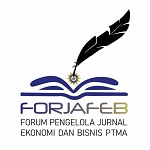THE EFFECT OF FINANCIAL RATIO ON FINANCIAL DISTRESS IN MINING COMPANIES
(1) Department of Accounting, Faculty of Economics and Business, Universitas Muhammadiyah Semarang
(2) Department of Accounting, Faculty of Economics and Business, Universitas Muhammadiyah Semarang
(3) Department of Accounting, Faculty of Economics and Business, Universitas Muhammadiyah Magelang
(4) Department of Accounting, Faculty of Economics and Business, Universitas Muhammadiyah Magelang
(*) Corresponding Author
Abstract
Full Text:
PDFReferences
Abdu, E. (2022). Financial distress situation of financial sectors in Ethiopia: A review paper. Cogent Economics and Finance, 10(1). https://doi.org/10.1080/23322039.2021.1996020
Ashraf, S., GS Félix, E., & Serrasqueiro, Z. (2019). Do traditional financial distress prediction models predict the early warning signs of financial distress? Journal of Risk and Financial Management, 12(2), 55.
Baghai, R. P., Silva, R. C., Thell, V., & Vig, V. (2021). Talent in Distressed Firms: Investigating the Labor Costs of Financial Distress. Journal of Finance, 76(6), 2907–2961. https://doi.org/10.1111/jofi.13077
Brigham, E. F., & Houston, J. F. (2021). Fundamentals of financial management. Cengage Learning.
Crespí-Cladera, R., Martín-Oliver, A., & Pascual-Fuster, B. (2021a). Financial distress in the hospitality industry during the Covid-19 disaster. Tourism Management, 85, 104301.
Crespí-Cladera, R., Martín-Oliver, A., & Pascual-Fuster, B. (2021b). Financial distress in the hospitality industry during the Covid-19 disaster. Tourism Management, 85(February). https://doi.org/10.1016/j.tourman.2021.104301
de Haan, T., Offerman, T., & Sloof, R. (2011). Noisy signaling: Theory and experiment. Games and Economic Behavior, 73(2), 402–428. https://doi.org/10.1016/j.geb.2011.04.006
Diyanto, V. (2020). The effect of liquidity, leverage and profitability on financial distress. Indonesian Journal of Economics, Social, and Humanities, 2(2), 127–133.
Fitri, M. A., & Dillak, V. J. (2020). Arus Kas Operasi, Leverage, Sales Growth Terhadap Financial Distress. Jurnal Riset Akuntansi Kontemporer, 12(2), 60–64. https://doi.org/10.23969/jrak.v12i2.3039
Fizabaniyah, R., & B, N. N. (2023). Financial Ratio , Board Diversity and Financial Distress : Evidence from Indonesia (Vol. 1). Atlantis Press International BV. https://doi.org/10.2991/978-94-6463-154-8
Indarti, M. G. K., Widiatmoko, J., & Pamungkas, I. D. (2020). Corporate Governance Structures and Probability of Financial Distress: Evidence From Indonesia Manufacturing Companies. International Journal of Financial Research, 12(1), 174. https://doi.org/10.5430/ijfr.v12n1p174
Jaimuk, P., Nilapornkul, N., & Ngudgratoke, S. (2020). Impact of a mediator on corporate governance characteristics and real earning management of Thai listed companies. Test Engineering and Management, 83(August 2021), 5912–5924. https://www.scopus.com/inward/record.uri?eid=2-s2.0-85083000162&partnerID=40&md5=2d3e3b8c33311fdaee636eba43732f44
Kasmir. (2008). Analisis Laporan Keuangan. PT Raja Grafindo Persada.
Khafid, M., Tusyanah, T., & Suryanto, T. (2019). Analyzing the determinants of financial distress in Indonesian mining companies. International Journal of Economics and Business Administration, 7(4), 353–368. https://doi.org/10.35808/ijeba/349
Kisman, Z., & Krisandi, D. (2019). How to Predict Financial Distress in the Wholesale Sector: Lesson from Indonesian Stock Exchange. Journal of Economics and Business, 2(3), 569–585. https://doi.org/10.31014/aior.1992.02.03.109
Kliestik, T., Valaskova, K., Lazaroiu, G., Kovacova, M., & Vrbka, J. (2020). Remaining financially healthy and competitive: The role of financial predictors. Journal of Competitiveness, 12(1), 74–92. https://doi.org/10.7441/joc.2020.01.05
Kusumayani, N. L., Widanaputra, A. A. G. ., Wirama, D. G., & Budiasih, I. G. A. N. (2019). The Ability of Good Corporate Governance in Moderating the Effects of Financial Distress on the Velocity of Publication of the Financial Statements. International Journal of Multicultural and Multireligious Understanding, 6(5), 80. https://doi.org/10.18415/ijmmu.v6i5.1056
Machfiroh, I. S., Pyadini, A. N., & Riyani, A. (2020). Analysis Of The Effect Of Liquidity, Solvability And Profitability On Stock Prices In Agricultural Sectors Listed In Indonesia Stock Exchange (IDX). Bilancia: Jurnal Ilmiah Akuntansi, 4(1), 22–34.
Mesak, D. (2019). Financial Ratio Analysis in Predicting Financial Conditions Distress in Indonesia Stock Exchange. Russian Journal of Agricultural and Socio-Economic Sciences, 86(2), 155–165. https://doi.org/10.18551/rjoas.2019-02.18
Nurcahyono, N., Hanum, A. N., Kristiana, I., & Pamungkas, I. D. (2021). Predicting fraudulent financial statement risk: The testing dechow f-score financial sector company inindonesia. Universal Journal of Accounting and Finance, 9(6), 1487–1494. https://doi.org/10.13189/ujaf.2021.090625
Nurcahyono, N., Hanum, A. N., & Sukesti, F. (2021). COVID 19 Outbreak and Stock Market Return: Evidence from Indonesia. Jurnal Dinamika Akuntansi Dan Bisnis, 8(1), 47–58. https://doi.org/10.24815/jdab.v8i1.18934
Nurcahyono, N., Sukesti, F., & Alwiyah, A. (2021). Covid 19 Outbreak and Financial Statement Quality: Evidence from Central Java. AKRUAL: Jurnal Akuntansi, 12(2), 193. https://doi.org/10.26740/jaj.v12n2.p193-203
Permata, D., Utami, W., & Purnamasari, D. I. (2021). The impact of ethics and fraud pentagon theory on academic fraud behavior 1). Journal of Business and Information Systems, 3(1), 49–59. https://doi.org/10.36067/jbis.v3i1.88
Purnama, I. A., & Kusumawardhani, I. (2020). Mitigating Budgetary Slack with Moral Imagination and Clawback Provisions: An Experimental Study. Advances in Economics, Business and Management Research, 144(Afbe 2019), 96–100. https://doi.org/10.2991/aebmr.k.200606.015
Rafatnia, A. A., Ramakrishnan, S., Abdullah, D. F. B., Nodeh, F. M., & Farajnezhad, M. (2020). Financial distress prediction across firms. Journal of Environmental Treatment Techniques, 8(2), 646–651.
Rafatnia, A. A., Suresh, A., Ramakrishnan, L., Abdullah, D. F. B., Nodeh, F. M., & Farajnezhad, M. (2020). Financial distress prediction across firms. Journal of Environmental Treatment Techniques, 8(2), 646–651.
Rahma, A. M., B, N. N., & Sinarasri, A. (n.d.). Moderating Effects of Institutional Ownership on the Relation Between Capital Structure (Vol. 1). Atlantis Press International BV. https://doi.org/10.2991/978-94-6463-154-8
Religiosa, M. W., & Surjandari, D. A. (2021). The Relation of Company Risk, Liquidity, Leverage, Capital Adequacy and Earning Management: Evidence from Indonesia Banking Companies. Mediterranean Journal of Social Sciences, 12(1), 1. https://doi.org/10.36941/mjss-2021-0001
Restianti, T., & Agustina, L. (2018). The Effect of Financial Ratios on Financial Distress Conditions in Sub Industrial Sector Company. Accounting Analysis Journal, 7(1), 25–33. https://doi.org/10.15294/aaj.v5i3.18996
Saputri, L., & Asrori. (2019a). The Effect of Leverage, Liquidity and Profitability on Financial Distress with the Effectiveness of the Audit Committee as a Moderating Variable. Accounting Analysis Journal, 8(1), 38–44. https://doi.org/10.15294/aaj.v8i1.25887
Saputri, L., & Asrori, A. (2019b). The effect of leverage, liquidity and profitability on financial distress with the effectiveness of the audit committee as a moderating variable. Accounting Analysis Journal, 8(1), 38–44.
Sari, H., Prapanca, D., Setiyono, V., & Wanti, F. (2022). Impact of Liquidity, Profitability, and Debt Policy Against The Value Of The Company. Proceedings of the 3rd International Conference of Business, Accounting, and Economics, 2017. https://doi.org/10.4108/eai.10-8-2022.2320883
Sari, P. C. (2020). Pengaruh Audit Lag, Profitabilitas Dan Likuiditas Terhadap Opini Audit Going Concern Pada Perusahaan Manufaktur Yang Terdaftar Di Bursa Efek Indonesia. Jurnal Riset Akuntansi Warmadewa, 1(1), 1–7. https://doi.org/10.22225/jraw.1.1.1509.1-7
Sekaran, U., & Bougie, R. (2019). Research methods for business: A skill building approach. john wiley & sons.
Trisanti, T. (2019). Earning Quality and Tax Planning: Evidence on Indonesia Listed Company. Jurnal Manajemen Dan Kewirausahaan, 21(2), 154–162. https://doi.org/10.9744/jmk.21.2.154-162
Article Metrics
Abstract view : 234 timesPDF - 0 times
DOI: https://doi.org/10.26714/vameb.v19i2.12791
Refbacks
- There are currently no refbacks.
Copyright (c) 2023 Value Added : Majalah Ekonomi dan Bisnis
--------------------------------------------------------------------------------------------------------------------------------------------------------------------------------------------
Address:
Department of Management
Faculty of Economics
University of Muhammadiyah Semarang
Kedungmundu Raya Road No. 18, Tembalang, Semarang, Central Java, Indonesia
Contact:
email: [email protected]










